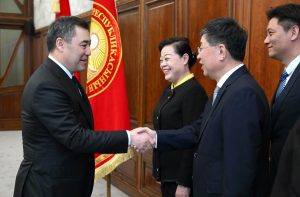Construction of the China-Kyrgyzstan-Uzbekistan (CKU) railway will begin in October, according to Kyrgyz President Sadyr Japarov.
Speaking during a working trip to Osh on May 6, Japarov said that at present, “Kyrgyzstan is a dead-end state in terms of logistics.” According to local media reports, he emphasized that Kyrgyzstan accesses the world via Kazakhstan’s and Russia’s railways. “When the [CKU] railway is built, we will be able to go out into the world.”
“In October, construction of the China-Kyrgyzstan-Uzbekistan railway is planned to begin. We will become a transit country for the world. We will enter the world market. Through the railway we will go out to the sea,” he reportedly said.
Kyrgyzstan, like all of Central Asia, is landlocked (Uzbekistan is double landlocked). To reach the sea, and via international shipping the world’s markets, Kyrgyz goods most often travel through either Kazakhstan and Russia, or China. The CKU railway has long been contemplated, but its geopolitical moment arrived with the 2022 Russian invasion of Ukraine and ensuing war.
The CKU railway is expected to shorten the route from China to Europe by 900 kilometers, cutting transit times for freight by an estimated eight days – while avoiding Russian territory and the Trans-Siberian railway. The bulk of the planned construction will take place in Kyrgyzstan and western China, as Uzbekistan already has a well-developed domestic rail network.
According to reporting by RFE/RL, Kyrgyz authorities are eyeing a 311-kilometer route across the country, which will run from Torugart to Kosh-Dobo and Kazarman and on to Jalal-Abad near the Uzbek border in the famed Fergana valley. In March, Japarov met with the deputy general director of China State Railway Group and the two sides said they had “reached a common understanding on the mechanism for implementing the project.” The cost of construction for the Kyrgyz portion was estimated at $4.7 billion in a feasibility study completed in June 2023.
In April, Chairman of the Cabinet of Ministers Akylbek Japarov said the feasibility study was being updated and cited the total cost of the project as $8 billion.
Financing remains a core problem. As Kyrgyz economist and analyst Iskender Sharsheev told RFE/RL in a recent interview: “Without the support of large international and regional investors, as well as possible financial assistance from international financial organizations, independent financing for the Kyrgyz Republic may prove to be an impossible task.”
Although construction will certainly generate short-term employment, the medium and long term impacts are less concrete. Kyrgyz officials, like Japarov, characterize the project as opening Kyrgyzstan’;s access to the world. But analyst Niva Yau told Navruz Karimov and Abror Kurbonmuratov, reporting for The Diplomat last October, that the most likely outcome is that the already unbalanced trade relationship between Kyrgyzstan and China would remain. “What is realistic is actually using the railway to import more Chinese products and open up more space, however small, for some Central Asian products to sell to China,” Yau said.
In 2022, nearly half (48 percent) of Kyrgyz exports went to Russia, followed by 18 percent to Kazakhstan and 11 percent to Uzbekistan – China trailed behind Turkey (6.2 percent), receiving a measly 2.7 percent of Kyrgyz exports that year. Imports present a different flow, with 42 percent of imports into Kyrgyzstan originating in China in 2022, 25 percent in Russia, and 7.9 percent in Kazakhstan. For much of the last decade, Kyrgyzstan has run a negative balance of trade. A rail line through Kyrgyzstan to Uzbekistan, with Europe at the far end of that transit route, would arguably serve to deepen that imbalance.
While construction may begin in October, as Japarov suggests, the considerable questions about the financing of the project and the long-term impact will remain. Furthermore, the geopolitical shift that lent renewed energy to the project could very well shift again before work is completed.
And the work will be considerable. In October 2023 RFE/RL reported that the rail line through Kyrgyzstan will require “more than 50 tunnels and 90 bridges through Kyrgyzstan’s highest mountains.” None of this makes the project impossible or unfeasible – that’s for engineers to decide – but it does add layers of difficulty to the railway, and that’s before considering the risks of corruption in such an enormous undertaking.

































